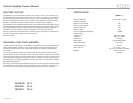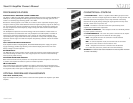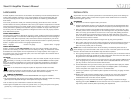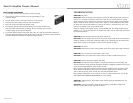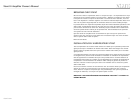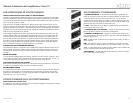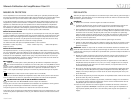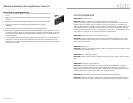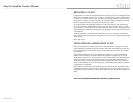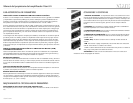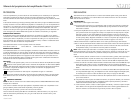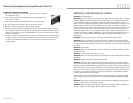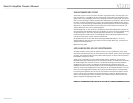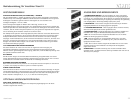
xtant.com
Xtant1.1i Amplifier Owner’s Manual
GAIN CONTROL ADJUSTMENT
1. Turn the Gain control all the way down (counter-clockwise)
2. Set the volume control of the source unit to approximately
2
⁄3 of its
maximum output
3. Turn the balance control of the source unit to its center position
4. Leave the tone (bass/treble) controls at their usual position
5. Play a CD or tape track with wide dynamic range
6. To locate the optimum input sensitivity setting, turn the
Gain control clock-
wise until audible distortion starts to develop. Turn the sensitivity control counter-
clockwise slightly to minimize the distortion.
7. If you often switch between sources (CD, tape, radio, etc.) you will need further adjustment
since radio output level differs from that of CD or tape. In this case, you need to locate a balanced
sensitivity setting which is best for the output level of your sources.
9
TROUBLESHOOTING
SYMPTOM: No power
SOLUTION: Check connections to the amplifier’s Ground, B+ & Remote terminals. Check con-
nection at “+” terminal of the battery. Check the remote turn-on terminal. Ensure it receives
power when the source is turned on (or when the switch is turned on). Refer to the Installation
Section. Check the power line fuse: if fuse is blown, replace it; if fuse continues to blow, check
the power wire and also the amplifier for a short. If the short is in the power wire, fix it; if the
short is in the amplifier itself, see your Xtant dealer.
Check the voltage at the amplifier, and the remote ON/OFF lead. The voltage should measure
between 11 V - 15 V. If the measurement is beyond this range, have the source unit checked out
by an authorized dealer.
SYMPTOM: Power without sound with red power indicator on
SOLUTION: Turn the amplifier off, and Check all input & output signal cables and connections.
Check the speakers for short with a VOM (volt meter) or by connecting them to another audio
system. After making sure everything is normal, turn the amplifier on again.
SYMPTOM: No sound
SOLUTION: Check balance control. Check speaker connections. Check signal input connection.
SYMPTOM: Very low sound from both radio & other source
SOLUTION: Check your radio’s fader control. Check the amplifier’s Input Sensitivity Level.
SYMPTOM: Frequent automatic amplifier shut down
SOLUTION: This indicates that the amplifier is operating continually at an exceedingly high
internal temperature. High operating temperature caused by inadequate ventilation: Refer to the
sub-section titled LOCATION for better amplifier location.
High operating temperature caused by an excessively low impedance load, say below 2 ohms
stereo: Check for bad speakers and/or electronic crossover, proper passive crossover compo-
nents; if difficulty persists, please consult your local authorized Xtant retailer.
High operating temperature can be caused by an incorrect input sensitivity level: refer to sub-
section titled GAIN CONTROL ADJUSTMENTS for correct setting.
SYMPTOM: “Motorboating”: The amplifier power indicator going off repeatedly when the
audio system is on
SOLUTION: Check the amplifier’s connection to the battery.
Check battery voltage. If low,
recharge or replace battery. Check all ground connections.




